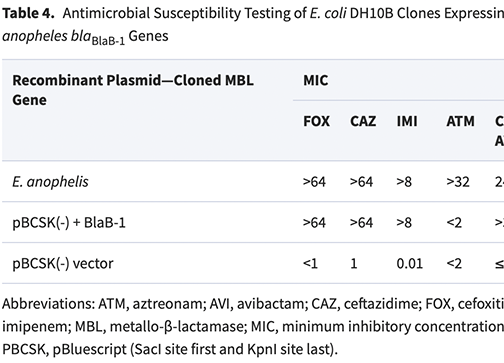Characterization of a Novel Pathogen in Immunocompromised Patients: Elizabethkingia anophelis—Exploring the Scope of Resistance to Contemporary Antimicrobial Agents and β-lactamase Inhibitors
Mohamad Yasmin, Laura J Rojas, Steven H Marshall, Andrea M Hujer, Anna Cmolik, Emma Marshall, Helen W Boucher, Alejandro J Vila, Maxime Soldevila, Seydina M Diene, Jean-Marc Rolain, Robert A Bonomo
Open Forum Infectious Diseases, Volume 10, Issue 2, February 2023,
https://doi.org/10.1093/ofid/ofad014 | PMC9938519
Abstract
Elizabethkingia anophelis is an emerging Gram-negative nonlactose fermenter in the health care setting, where it causes life-threatening infections in immunocompromised patients. We aimed to characterize the molecular mechanisms of antimicrobial resistance and evaluate the utility of contemporary antibiotics with the intent to offer targeted therapy against an uncommonly encountered pathogen.
Whole-genome sequencing (WGS) was conducted to accurately identify isolate species and elucidate the determinants of β-lactam resistance. Antimicrobial susceptibility testing was performed using broth microdilution and disk diffusion assays. To assess the functional contribution of the major metallo-β-lactamase (MBL) encoding genes to the resistance profile, blaBlaB was cloned into pBCSK(-) phagemid vector and transformed into Escherichia coliDH10B.
WGS identified the organism as E. anophelis. MBL genes blaBlaB-1and blaGOB-26 were identified, in addition to blaCME-2, which encodes for an extended-spectrum β-lactamase (ESBL). Plasmids were not detected. The isolate was nonsusceptible to all commonly available β-lactams, carbapenems, newer β-lactam β-lactamase inhibitor combinations, and to the combination of aztreonam (ATM) with ceftazidime-avibactam (CAZ-AVI). Susceptibility to the novel siderophore cephalosporin cefiderocol was determined. A BlaB-1 transformant E. coli DH10B isolate was obtained and demonstrated increased minimum inhibitory concentrations to cephalosporins, carbapenems, and CAZ-AVI, but not ATM.
Using WGS, we accurately identified and characterized an extensively drug-resistant E. anophelis in an immunocompromised patient. Rapid evaluation of the genetic background can guide accurate susceptibility testing to better inform antimicrobial therapy selection.
Source: https://www.ncbi.nlm.nih.gov/pmc/articles/PMC9938519/





